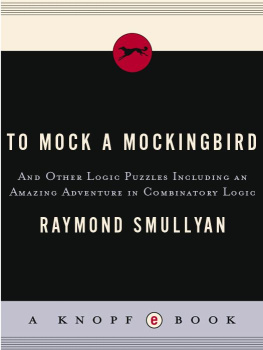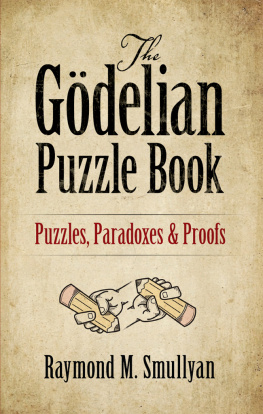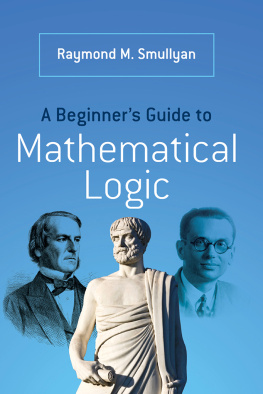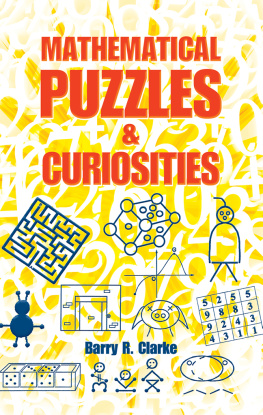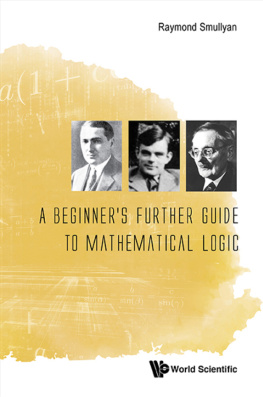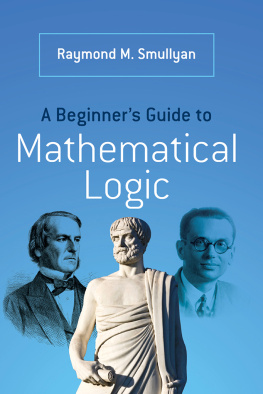FOUR LIVES
A Celebration of
Raymond Smullyan
Edited and with an Introduction by
Jason Rosenhouse
Dover Publications, Inc.
Mineola, New York
ACKNOWLEDGMENTS
Excerpt from THE RIDDLE OF SCHEHERAZADE: AND OTHER AMAZING PUZZLES, ANCIENT AND MODERN by Raymond M. Smullyan, copyright 1997 by Raymond Smullyan. Used by permission of Alfred A. Knopf, an imprint of the Knopf Doubleday Publishing Group, a division of Random House LLC. All rights reserved.
Planet Without Laughter reprinted with the permission of Simon & Schuster Publishing Group from THIS BOOK NEEDS NO TITLE by Raymond Smullyan. Copyright 1980 by Raymond Smullyan. All rights reserved.
Chapter 22: Is God a Taoist? (pp. 86110) from THE TAO IS SILENT by Raymond Smullyan. Copyright 1977 by Raymond M. Smullyan. Reprinted by permission of HarperCollins Publishers.
Copyright
Copyright 2014 by Jason Rosenhouse
Afterword: Rambles and Reflections copyright 2014 by Raymond Smullyan Raymond Smullyan excerpts copyright 1977, 1978, 1979, 1980, 1982, 1992, 1997, 2010 by Raymond Smullyan.
All rights reserved.
Bibliographical Note
Four Lives: A Celebration of Raymond Smullyan is a new work, first
published by Dover Publications, Inc., in 2014.
Library of Congress Cataloging-in-Publication Data
Smullyan, Raymond M., author.
[Works. Selections]
Four lives : a celebration of Raymond Smullyan / edited by Jason Rosenhouse.
p. cm.
Summary: This best of collection of works by Raymond Smullyan features excerpts from his published writings, including logic puzzles, explorations of mathematical logic and paradoxes, retrograde analysis chess problems, jokes and anecdotes, and meditations on the philosophy of religion. In addition, numerous personal tributes salute this celebrated professor, author, and logic scholar who is also a magician and musician.Provided by publisher.
e ISBN13: 978-0-486-78294-2
1. Mathematical recreations. 2. Logic puzzles. 3. Smullyan, Raymond M.Anecdotes. I. Rosenhouse, Jason, editor. II. Title.
QA95.S682 2014
511.3dc23
2013040855
Manufactured in the United States by Courier Corporation
49067X01 2014
www.doverpublications.com

Contents

J. Michael Dunn
Melvin Fitting
Douglas Hofstadter
Graham Priest

Introduction

There was a bookstore where I grew up called Titles Unlimited, and for me it was a good day indeed when my parents took me for a visit. We always had plenty of books and magazines lying around the house, which made reading seem to young me like just the coolest thing in the world. My father in particular was seldom without a book in his hand, and I definitely wanted to be just like him.
This was in the days before the Internet, when a trip to an actual bricks-and-mortar bookstore was the only way to find out what new books were available. That was fine by me, since by age nine I was already a skillful browser. I knew where all my favorite sections were, and upon being set loose I would proceed systematically to hit them all. Of particular interest was the "Games and Puzzles" section, since I was a budding young chess player, and that was the section that housed the chess books.
One day I struck out with the chess section, but happened to let my attention stray to the shelves of puzzle books. There was a slim volume with a striking yellow cover that caught my eye. It was called What is the Name of This Book? and was written by a fellow named Raymond Smullyan. I pulled it off the shelf, sat cross-legged on the floor, and was hooked within a few pages. Raymond opened the book with a handful of clever brainteasers, "Monkey Tricks" as he called them, and most of them were within my abilities at that time. I prevailed upon my parents to buy the book for me. No doubt thinking there were worse things I could be hooked on, they were happy to oblige.
I dove into the book as soon as I got home, but quickly hit a snag. You see, after the monkey tricks came a series of problems about knights and knaves. In these puzzles you were asked to imagine an island which is home to precisely two kinds of people. There were knights, who always told the truth, and knaves, who always lied. You were to play the role of a weary traveler who had landed on the island, desperately trying to discern some useful information from the cryptic remarks of the islands inhabitants. Alas, knights and knaves were visually indistinguishable, meaning the only way to determine who was who was to ferret out the logical consequences of their strange statements.
The first puzzle went like this: You encounter three inhabitants of the island. Let us call them A, B, and C. You ask A whether he is a knight or a knave, but his answer is an incoherent mumble. So you ask B to clarify what A said. He replies, "A said he was a knave." Whereupon C angrily cuts in to say, "Pay no attention to B, he is lying." From this we were supposed to conclude something or other.
I was baffled. No clue at all how to proceed. So I went to my father, who was a chemical engineer with some talent for analytical thinking. The way I remember it, both he and my mother were in the kitchen cleaning up after dinner. Oblivious to the fact that I was interrupting serious business, I thrust the book at my father and asked him how to solve the problem. He was slightly annoyed, but looked at the problem anyway. Seconds later, seemingly with no effort at all, he tossed off something like, "Well, no one can say he is a knave, since a knight who said that would be lying, while a knave who said that would be telling the truth. So B lied about what A said, meaning that B is a knave. That means that C was telling the truth when he said B was lying, so he is a knight. Cant say anything about A, though." Then he handed the book back to me and returned to his business.
I was impressed. I have a clear memory of thinking, "I want to be able to do that!" So I went back to my room and got to work. Many hours of enjoyable reading (interrupted by frequent bouts of blank wall-staring, of course), ensued. Eventually I got the hang of it, and while many of the puzzles remained beyond my nine-year-old abilities, I still could not get enough of them.
That might have been the end of it, but for a visit to the local public library sometime later. Once again I went straight to the chess section. This time I came to a volume with the strange title The Chess Mysteries of Sherlock Holmes, written, again, by Raymond Smullyan. This was another new world for me. The book featured a collection of chess problems that were unlike any I had ever seen. I was familiar with problems of the "White to play and mate in three" variety, but Smullyans puzzles were not like that at all. Instead we were asked to reconstruct some aspect of the play that led to the position on the board. In one problem we were told that some children had absconded with one of the pieces, and were asked to deduce, knowing only the square on which it belonged, which piece it was. Or maybe a piece had been carelessly placed on the border between two squares, and we were asked to adjust it to its proper place. Gradually working my way through the problems, I reprised my earlier experience with
Next page

